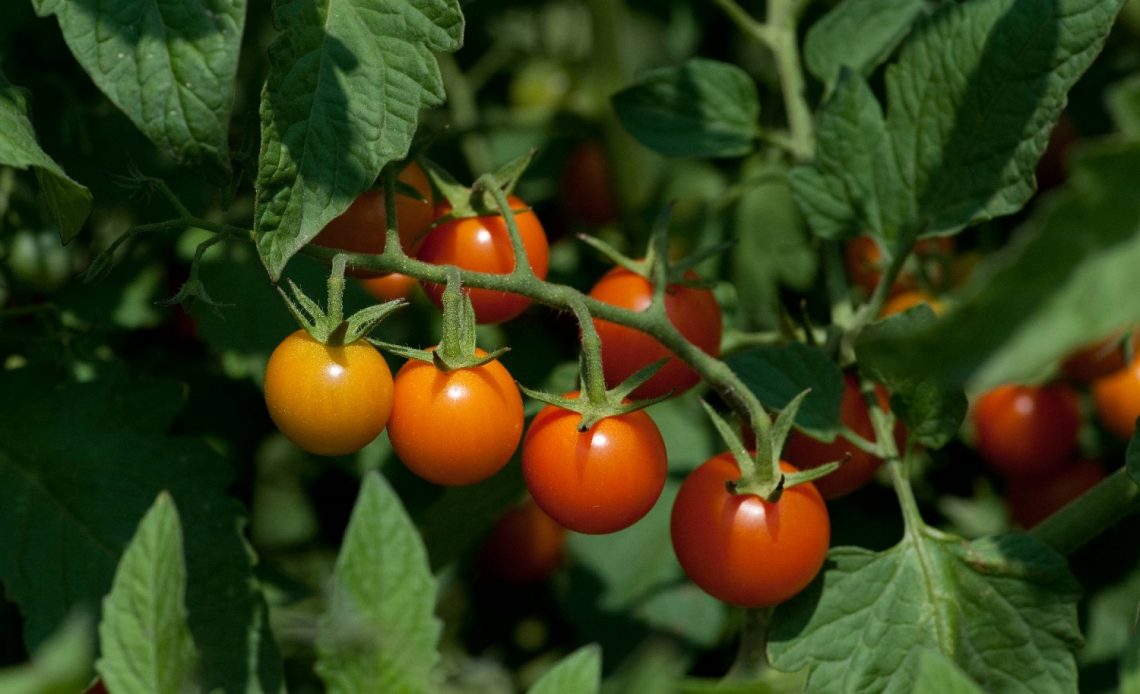

We’re here to help! Wild Yards is a completely free website that is 100% dedicated to helping you create a wildlife-friendly, sustainable yard. Read more
WildYards is reader-supported. When you buy a product through a link on our site, we may earn a comission. Every product is independently selected by our (obsessive) editors and our reviews are unbiased and objective. Read more about our mission or our privacy policy.
Cherry tomatoes are delicious salad staples that are always easy to grow! That said, they can grow out of control if left unmaintained. Some species need more TLC than others – but cherry tomato pruning doesn’t need to be daunting.
Fast-growing indeterminate cherry tomato plants need regular pruning to stop them from overcrowding your garden or greenhouse. Provided you leave a single stem and a couple of suckers, all you’ll need to do is keep trimming off new suckers as soon as they arise.
How do I know if I have indeterminate cherry tomatoes?
Indeterminate cherry tomatoes grow for longer than the determinate variety and have longer stems that grow wildly through warmer months. Determinate cherry tomato plants, meanwhile, tend to stop growing once they flower. You’ll find that an indeterminate species will keep growing even after it produces flowers.
Determinate cherry tomatoes don’t need as much attention as indeterminate plants – and you’ll normally grow this species in cages. Knowing the difference is crucial, as pruning a determinate plant incorrectly may result in stunting or harming the plant.
If you purchase seeds from a garden center or online, the packet or marketing description will likely tell you the variety you’re buying. Varieties such as Sweet Million and Yellow Pear fall under the indeterminate umbrella, while Mountain Belles and New Pearls are among the most popular determinate cherry tomato plants.
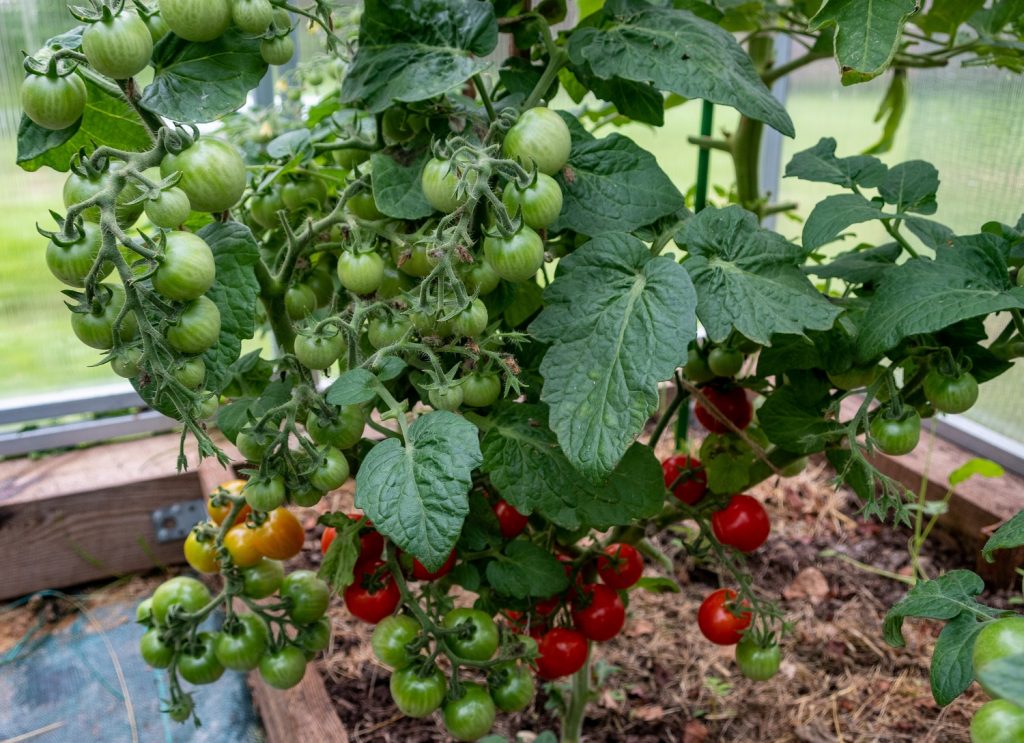
Do I need to prune cherry tomatoes?
Generally, yes – indeterminate cherry tomato plants need pruning, especially if you are growing them with other species in the same soil or container. Left to propagate without pruning, these plants spread thick and fast and may compete for nutrients, overshadowing sensitive species that need ample sunlight.
Leaving indeterminate cherry tomato plants to grow at speed may also encourage disease growth – as the airflow will decrease the thicker these specimens clump together. By effectively pruning your cherry tomatoes, you’ll help keep air flowing and prevent moisture from building up – which can prove detrimental to their growth.
You’ll also find that cherry tomato plants produce bigger, tastier yields – more quickly – when pruned effectively. The plant will simply continue to flower the more you pick fruit from its vines – and as they have more access to air and sunlight, the tomatoes will ripen much quicker than if left to proliferate on their own.
Pruning indeterminate cherry tomatoes is also an act of kindness – these plants won’t be able to support themselves if they grow too long, tall, and heavy. Tomato plants can catch diseases from any soil or ground they touch if left to hang – so be sure to either prune or trellis them.
Vitally, a pruned cherry tomato plant will be exposed to sunlight and will produce larger, tangier fruit for you to harvest. Additionally, you can expect a lower risk of disease in the leaves, as they will dry out faster.
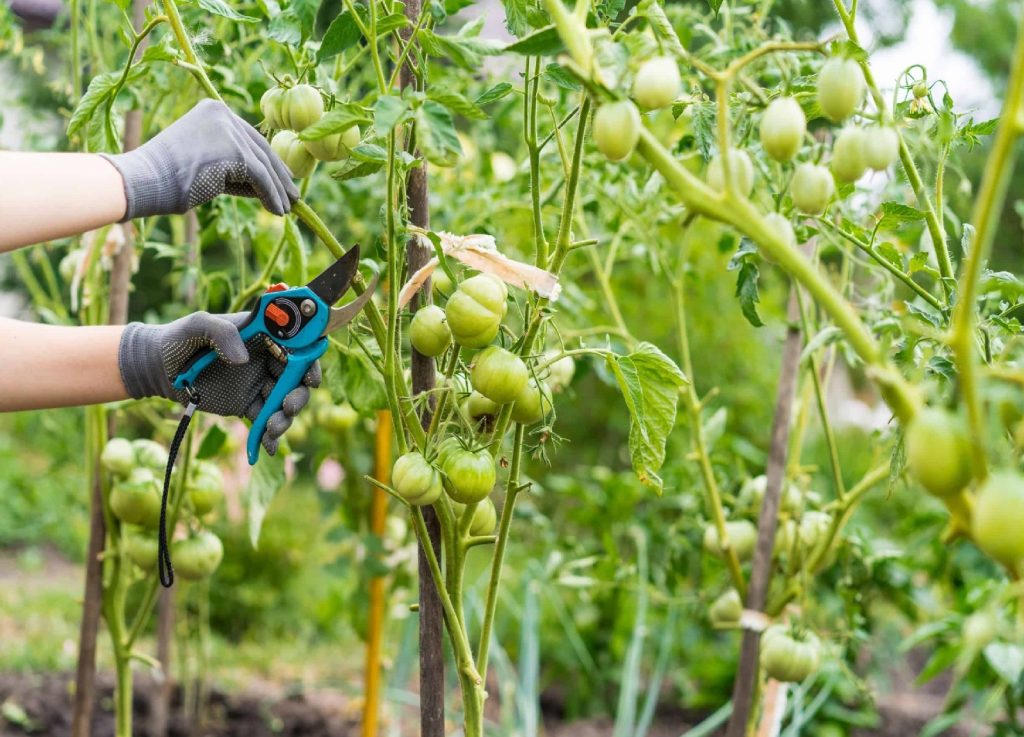
Should I prune determinate cherry tomatoes?
No – there’s no need to prune determinate tomatoes, as they’ll stop growing when they flower – meaning if you trim them back, they could stop growing again. It’ll also potentially stunt their tomato production.
If you must prune determinate cherry tomatoes, do so if their leaves are wilting, dying, or if you need to clip back some of its green foliage to provide better airflow. Never prune away suckers or flowers if you want your plant to continue producing fruit!
When should you prune cherry tomatoes?
You should ideally start to prune your cherry tomato plant as soon as you place it into the soil if you’re growing it from a seedling. You’ll need to take away leaves at the base and those that contact soil when fully planted. Upon first planting, removing flowers at this point is also prudent to help them grow back stronger and in greater yields.
From here, you probably won’t need to prune your plant again for another couple of weeks. Ideally, you should start to prune leaves again when the plants produce ripe fruit or when leaves start to go yellow.
If your cherry tomato plant is growing an abundance of suckers – small branches that sprout up across the stem – you’re likely to start growing smaller fruit in greater quantities. This isn’t ideal – meaning you’ll need to remove suckers on sight.
If left unpruned, suckers can thicken and harden into a stem, making it harder for future pruning attempts. Cherry tomato plants will grow multiple stems with little encouragement, making it tricky to tell the main stem apart from newer growths.
Otherwise, don’t be afraid to start pruning as soon as your indeterminate plant sprouts flowers. They may look nice, but this indicates the plant is in abundant growth mode – you should expect flowering at around 12” in height.
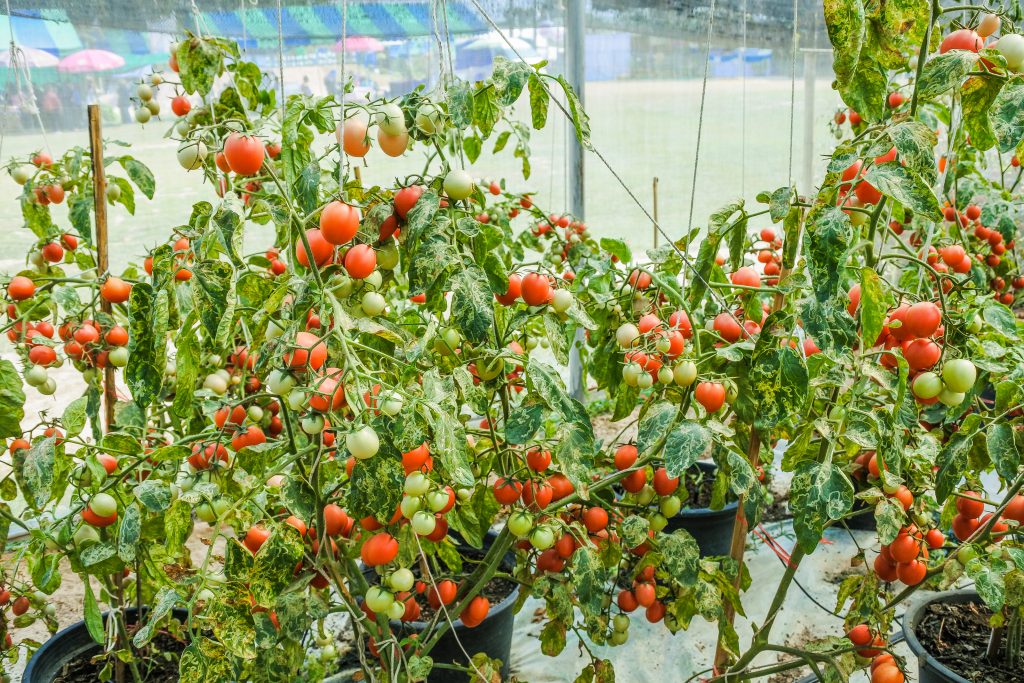
Cherry tomato pruning tools you’ll need
Some gardeners may prefer to prune plants such as cherry tomatoes by hand, but for the best accuracy, you should wield at least a pair of trimmers or specialist scissors that are small enough to get at tiny suckers. Choose a pair that’s weather-resistant if possible.
You typically won’t need more than pruning scissors or trimmers to take care of your cherry tomato plant, but it’s worth investing in some alcohol so you can sterilize points in your plant where diseases are likely to occur. Rubbing alcohol is great for gently adding to plants so they can withstand infections post-pruning.
You may also consider using a knife with a retractable blade. This is recommended if you want to pull or snap any suckers off yourself, but they prove too tough to budge.
Pruning your cherry tomatoes – the technique
Tools at hand, you’ll need to start looking for leaves and suckers that you can remove from your cherry tomato plant. Suckers will take vital energy away from your plant, which it could use to grow larger fruit in smaller quantities – and you’ll need to remove leaves to stop your plant from shielding and choking any other specimens close by.
The ideal technique for pruning cherry tomato plants is keeping a small number of stems to suckers. You’ll only need one stem and, at most, two suckers. These two suckers will be responsible for producing your fruit (as you’ll remove any new growths that emerge). Severing the main stem will risk killing the plant outright. In some cases, leaving two stems in place can still allow for excellent tomato yields – but a solo stem is your safest bet.
As your plant grows, allow the first sucker (of two) to grow and establish. This should normally be around a foot from the ground, and it’ll harden to establish a ‘junction’ shape with your main stem.
Keeping stems and suckers at a low ratio helps to improve your chances of harvesting larger, juicier fruit and ensuring your plants don’t overtake your plot.
Be careful when pruning leaves – you shouldn’t ever prune them when wet, as you’ll put your plant at risk of falling prey to a fungal disease. Pruning leaves for the first time is as simple as clipping away any leaves that grow beneath where your fruit emerges. This helps your plant to breathe easier and can prevent other specimens from losing sunlight.
It’s important to keep leaves growing above your tomato fruit where possible, as it is at risk of sun-scald. This leads to blistering and may provide an opportunity for black mold to develop. Allowing leaves to grow over your tomatoes (to an extent) can shield them from direct sunlight.
Any suckers that emerge in the following weeks must be clipped or twisted off as soon as you see them. Twisting off suckers by hand is possible if you catch them early enough, but keep your knife and/or trimming scissors to hand just in case. You’ll normally need to remove suckers once a week, if not twice a month, once the growth season starts coming to an end.
A word of warning – if you prefer the knife or clipper method, be careful not to damage any tissue adjacent to the plant. If a sucker proves too difficult to clip away with your trimmers, try the twist method. After around a month and a half of growth, you shouldn’t need to twist or remove suckers beyond twice a month – though some specimens will vary.
When should I pick my cherry tomatoes?
You should pick cherry tomatoes as soon as they are ripe – if you keep up to a healthy pruning schedule and water your plants regularly, maybe every other day at the height of summer.
You can tell when cherry tomatoes are ripe as they will be a bold red color – as you may find them in grocery stores. The key to harvesting cherry tomatoes is to be gentle – they are very easy to squash and won’t take much to remove. A slight pinch is all you need.
Harvesting ripe cherry tomatoes is also helpful in line with regular pruning – as picking fruit can encourage the plant to produce more specimens more frequently. With only a couple of active suckers, you can expect your plant to exert much of its energy into producing bigger, juicier tomatoes.
When should I trellis my cherry tomatoes?
When you start to notice your cherry tomatoes droop from their weight, it’s time to set up a trellis or a series of stakes. Allowing plants to grow up a trellis or series of bamboo canes is known as ‘training’.
Indeterminate cherry tomatoes can grow over eight feet tall if left to persist without pruning in full sun, which means you’ll need to support them with a trellis or cage as you approach the end of the growing season. Determinate cherry tomatoes, on the other hand, typically only grow to half this height.
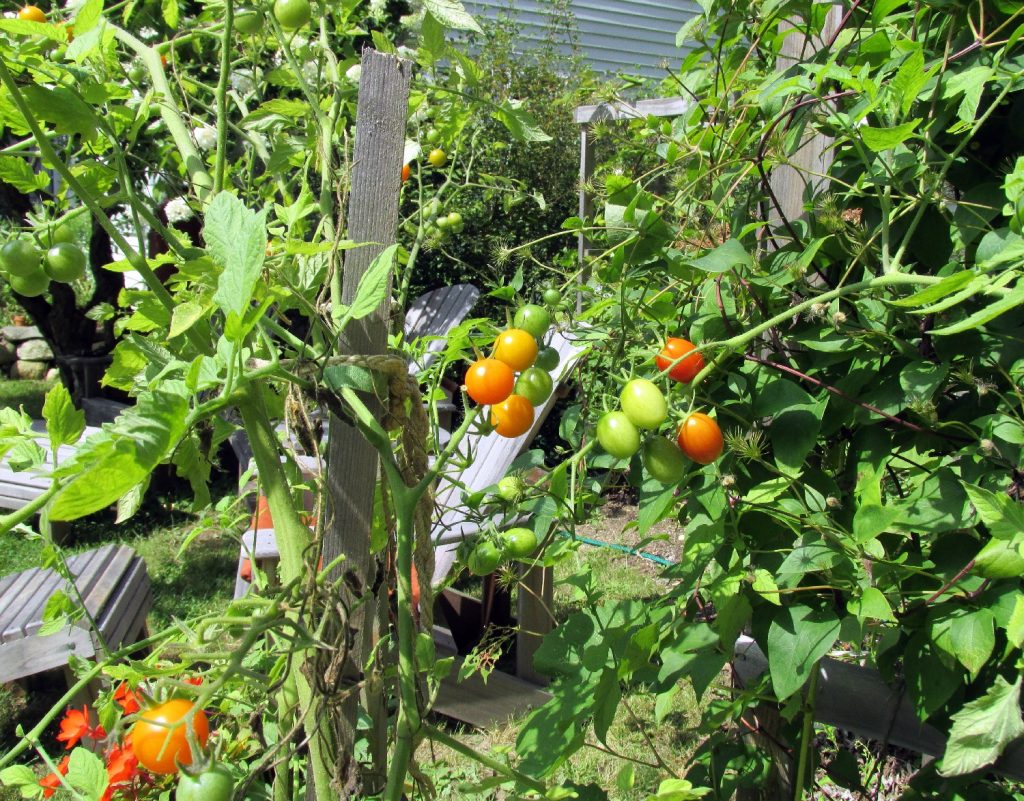
Should I train my cherry tomatoes after pruning?
By the time your cherry tomato plants are ready to trellis or train, you’ll likely already be pruning them regularly. You should have at least one stem and up to two suckers that solidify into ‘V’ shapes. You can anchor these ‘V’ shapes when starting to train your plants, choosing one or two to become ‘leader’ growths.
It’s possible to train more than one cherry tomato plant at once, providing you regularly prune them. You’ll need to allow around 12” between single leaders of each plant in rows.
Once you’ve established a regular pruning schedule, you can help to support and train cherry tomato plants with twine or clips to hold them in place. In some cases, you may prefer to set up tomato cages – a great option if you have at least four stems or leaders and want to carefully prune a section of plants. Be careful to keep up to your schedule when opting for cages, as indeterminate tomatoes will scale up the cages with abandon. They’re often best reserved for determinate tomatoes instead.
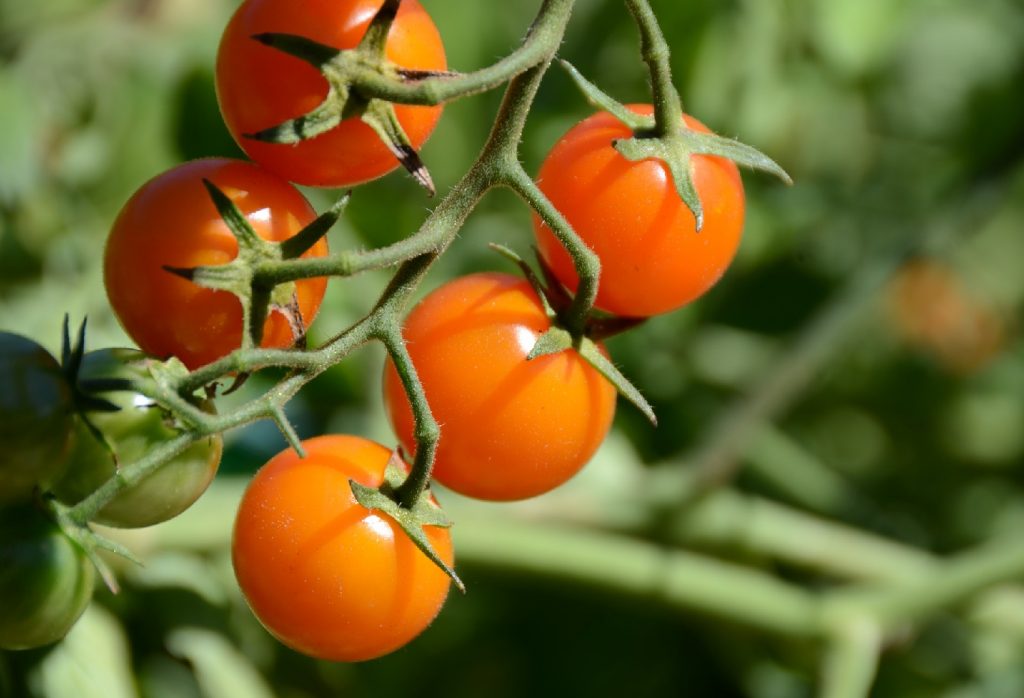
Is pruning cherry tomatoes difficult?
Some gardeners may be put off pruning cherry tomatoes as it demands regular work – but this is only the case with indeterminate species, and pruning helps to produce bigger and juicier fruit. Determinate plants are easier to look after, but may not provide you with the same yield of fruit to enjoy throughout the summer. There’s no harm in growing a variety of determinate and indeterminate plants across your garden if you’d like to try them both.
Growing other plants with cherry tomatoes can be difficult as the indeterminate species is such a fervent climber – but providing you carefully clip away leaves and twist away suckers when they emerge, you can grow a rich crop that won’t ‘bully’ other vegetables into submission. Plants you can easily grow alongside cherry tomatoes – that can help promote healthier growth – include chives, basil, yarrow, and chamomile.
Cherry tomatoes are delicious and propagate wildly in the warmer months, meaning if you look after your specimens appropriately, you can expect free salad for the summer. Pruning only becomes painstaking when you let your indeterminate stems and suckers solidify and split – for the biggest, juiciest tomatoes, restrict those stems and twist off suckers as soon as you spot them. It’s immensely satisfying, all the same!
